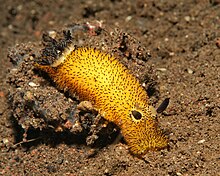Jorunna parva
| Jorunna parva | |
|---|---|

| |
| Jorunna parva | |
| Scientific classification | |
| Kingdom: | |
| Phylum: | |
| Class: | |
| Order: | |
| Family: | |
| Genus: | |
| Species: | J. parva
|
| Binomial name | |
| Jorunna parva | |
| Synonyms[2] | |
|
Thordisa parva Baba, 1938 | |


Jorunna parva, commonly known as the sea bunny, is a species of dorid nudibranch, a shell-less marine gastropod mollusc in the family Discodorididae. The species was first described by Kikutaro Baba.[2] Its resemblance to a rabbit facilitated a surge in popularity on Twitter throughout Japan in 2015.[3]
Description[edit]
The species is about 1 cm long on average. Its black-and-white rhinophores somewhat resemble a rabbit's ears. Its external gills are located near its rear. Its body is covered in papillae, fleshy protuberances used for sensory functions, giving it the appearance of a furry animal.[4] There are multiple colorations of Jorunna parva, including yellow, white, and green, though the latter is rarely photographed.[5] All of these variants have black papillae interspersed among papillae of their main color. There is controversy over whether or not the different colorations are divergent species.[5]
Like most other members of its genus, Jorunna parva's diet consists of toxic sponges in the family Chalinidae. These sponges contain toxins that can be used for cancer treatments.[6]
Jorunna parva are hermaphrodites, meaning they produce both sperm and egg cells. They cannot fertilize the eggs themselves.[5]
Distribution[edit]
This species was described from Kii Province, Japan. Jorunna parva has subsequently been reported from the Philippines, Tanzania, Papua New Guinea, Seychelles and Réunion but there are some doubts as to whether it is really a species complex.[7] The Jorunna parva are concentrated in areas where there is an abundance of food and where resources are easily acquired.[8] They often cling to submerged vegetation and spend majority of the time at the bottom of tropical waters.[9]
References[edit]
- ^ Baba, K. (1938) Opisthobranchia of Kii, Middle Japan. Journal of the Dept of Agriculture, Kyushu Imperial University, 6(1): 1–19.
- ^ a b Bouchet, P. (2010). Jorunna parva (Baba, 1938). World Register of Marine Species.
- ^ Kearns, Landess (July 15, 2015). "Fluffy Bunny Sea Slugs Make Us Want To Cuddle Them". Huffington Post.
- ^ Dr. M (July 19, 2015). "The Science of Sea Bunnies: You'll Never Believe The Top Ten List We Created To Get You To Visit Our Website". Deep Sea News. Retrieved November 30, 2017.
- ^ a b c Badore, Margaret (July 20, 2015). "The adorable science behind the "sea bunny"". Treehugger.com. Retrieved November 30, 2017.
- ^ "Meet the Adorable "Sea Bunny" Taking Over the Internet". National Geographic News. 2015-07-23. Archived from the original on July 25, 2015. Retrieved 2019-04-13.
- ^ Rudman, W.B., 2000 (July 4) Jorunna parva? (Baba, 1938). [In] Sea Slug Forum. Australian Museum, Sydney.
- ^ M, Dr (2015-07-19). "The Science of Sea Bunnies: You'll Never Believe The Top Ten List We Created To Get You To Visit Our Website". Deep Sea News. Retrieved 2019-04-13.
- ^ "Sea Slug | Encyclopedia.com". www.encyclopedia.com. Retrieved 2019-04-13.
- Camacho-García Y.E. & Gosliner T.M. (2008). Systematic revision of Jorunna Bergh, 1876 (Nudibranchia: Discodorididae) with a morphological phylogenetic analysis. Journal of Molluscan Studies 74: 143–181
